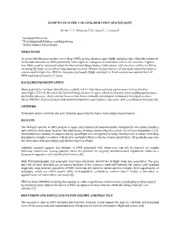
NASA Technical Reports Server (NTRS) 20110023263: Slow Wave Sleep and Long Duration Spaceflight PDF
Preview NASA Technical Reports Server (NTRS) 20110023263: Slow Wave Sleep and Long Duration Spaceflight
SLOW WAVE SLEEP AND LONG DURATION SPACEFLIGHT M. Orr 1, A. Whitmire 2, D. Arias 2, L. Leveton3 1 Auckland University 2 Wyle Integrated Sciences and Engineering 3 NASA Johnson Space Center OBJECTIVES To review the literature on slow wave sleep (SWS) in long duration space flight, and place this within the context of the broader literature on SWS particularly with respect to analogous environments such as the Antarctic. Explore how SWS could be measured within the International Space Station (ISS) context with the aim to utilize the ISS as an analog for future extra-orbital long duration missions. Discuss the potential use of emergent minimally intrusive wireless technologies like ZEO for integrated prelaunch, flight, and return to Earth analysis and optimization of SWS (and general quality of sleep). BACKGROUND/MOTIVATION Sleep degradation has been identified as a central risk for individual and crew performance in long duration spaceflight [,2,3,4,5]. Research has assessed sleep duration in space, which is critical to understanding performance and health outcomes; sleep structure however has been minimally investigated. Laboratory investigations have shown SWS has been associated with important reparative and cognitive and motor skill consolidation functions [6]. METHODS Systematic search of formal and grey literature augmented by liaison with subject matter experts. RESULTS The literature specific to SWS analysis in space was limited with understandably cumulatively low subject numbers and relatively short study duration, but with the key findings emphasizing the central risk of sleep degradation [2,5]. Neurobehavioral declines in subjects during spaceflight were recognized as being multifactorial in nature with sleep degradation strongly correlated with decline and highly likely to be the central causal factor. Of particular note was the observation that neurobehavioral decline begins preflight. Antarctic research suggests that declines in SWS associated with winter-over can still be detected six months following winter-over, raising concerns about the potential for ongoing neurobehavioral impairment related to a decrease in reparative and consolidation function [6]. Both Polysomnography and actigraphy have been effectively utilized for in-flight sleep data acquisition. The pros and cons of these measures are recognized in terms of the respective trade-offs between the relative gold standard diagnostic sleep structure specificity of PSG versus the less intrusive nature and less complex field requirements of actigraphy which can afford greater utility in longitudinal, ambulatory contexts (but is limited to providing an approximation of wakefulness and sleep) [6]. ZEO has been identified as having the capacity to make a significant complementary contribution to sleep research by providing (with relative limitations to PSG) an analysis of sleep structure while also being relatively non- intrusive [1]. DISCUSSION AND IMPLICATIONS FOR THEORY AND PRACTICE The research to date on SWS including that from the Antarctic would support the need for a holistic and integrated view of risk assessment and countermeasures throughout the mission preparation, flight and return cycle. ZEO is an emergent wireless system with the ability to capture and analyze sleep structure, via a single relatively unobtrusive head band sensor [1]. From a user perspective, ZEO aligns with the daily tasks which may increase adherence and utility for more longitudinal ambulatory context research. ZEO has the potential to facilitate longer term analysis of both sleep structure and change, and the capacity for intervention throughout the mission cycle including response to sleep education, lighting treatment, Cognitive Behavioral Therapy, medication, and psychosocial environmental change. A key issue for extra-orbital LDM will be dynamic autonomy capacity, or the capacity of the crew and craft to exhibit various levels of autonomy (including biopsychosocial healthcare) in the event of a limited or failed link with mission control. ZEO’s wireless capability and its potential for integrated local and remote analysis afford opportunities to develop technical and clinical skill base and models in expert systems, tele-monitoring and telemedicine and related integrated stepped care, which could also provide benefits for the general populace. REFERENCES [1]Dickinson, D. et al (2011). Patent No. EP20090822646. United States of America. [2] Dijk, D. J., Neri, D., Wyatt, J., & Rhonda, J. (2001). Am J Physiol 281, R1647-R1664. [3] Gundel, A., Polyakov, V. V., & Zulley, J. (1997). J Sleep Research , 6, 1-8. [4] Mallis, M. M., & DeRoshia, C. W. (2005). Aviat Space Environ Med 76 (6, Suppl.), B94-107. [5] Monk, T. et al (1998). J Biological Rhythms , 13, 188-201. [6] Otto, C. (2007). (White Paper). NASA Johnson Space Center
